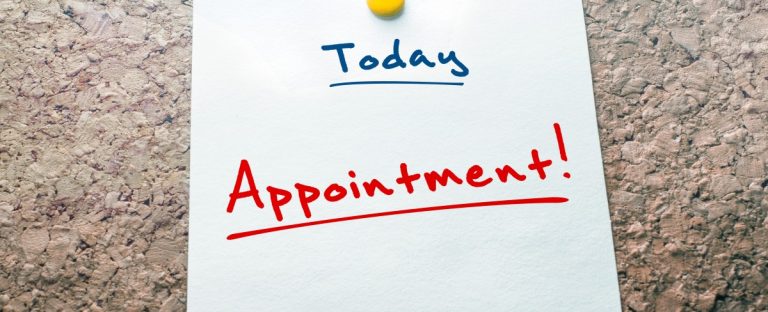No-show patients can be costly to your practice in terms of both impacting your overall healthcare revenue cycle and productivity. When patients schedule appointments, that blocks out the time from another client booking that slot—so when nobody shows up for the time slot, you and your practitioners are left to fill the time how you each see fit.
Your holistic practice is there to deliver great care to the people in your community, so when patients don’t show up for their appointments and haven’t made any contact to let you know what’s going on with their schedule, it can be frustrating and costly.
If you find that your holistic practice is constantly dealing with no-show patients that affect your revenue stream and daily workflows, then try some of these tips below to help mitigate these unexpected absences.
Should Your Holistic Practice Have a Policy for No-Show Patients In Place?
The short answer: yes, definitely! No-show policies help you outline what constitutes a no-show patient, what options a no-show patient has to reschedule or cancel, and what consequences there are for repeat offenders.
Simply putting these components together into a document that is made available to patients, whether new or returning, can help your clients understand their role in keeping their appointment. Disseminating an email, having a notice on your website or scheduling software, and having a brief conversation over the phone, when relevant, clarifies what will happen if a patient misses their time slot; if patients don’t know that they have options to adjust their time slot, then they might be a no-show because they’re unaware!
A no-show policy doesn’t have to be an extensive document, but it should contain a few core parts that illustrate what your practice designates as a no-show patient and how the patient can proceed if they need to reschedule or cancel their appointment.
Consider adding these sections:
- Briefly describe what is a no-show patient and how this differs from a patient who calls to cancel
- Establish fees for canceling or incentivize patients to keep their appointments with your practice
- Explain how patients can take control of their time slot by rescheduling or canceling their appointment altogether instead of simply not showing up
- Outline what might happen if a patient is consistently making and not keeping their appointments; for example, if a patient is a no-show to more than 3 appointments, then they need to call your practice to schedule an appointment instead of using an online booking system
Determining a no-show policy for your holistic practice can save you a lot of headaches and better inform your patients of their options and responsibilities.
How Much Are No-Show Patients Actually Costing Your Holistic Practice?

Let’s break down how much no-show appointments are actually costing your holistic practice.
For example, if each appointment brings in about $100 and you’re having a no-show once a day, then the math looks like this:
$100/day x 5 days a week = $500/week in lost revenue
Of course, substitute in the frequency and actual revenue per appointment that pertains to your holistic practice; regardless, no-shows are definitely costing you.
Going back to the example above, over the course of a year, your holistic practice is losing around $25,000. That’s a significant amount of revenue and that’s why addressing no-shows—with the help of a policy and a few tips below—is important to the financial success of your practice.
Maximize Productivity and Minimize No-Show Patients with These 3 Tips
You can help keep the wheels of your holistic practice running smoothly with these tips to maximize productivity and minimize no-show patients:
Open the Lines of Communication with Your Patients
Life happens, of course, so it’s not uncommon for your practice to have no-show patients. But having a conversation with them about why they missed their appointment can be a strong indicator of how your practice can help them in the future!
For example, if a patient says that they didn’t show up to the appointment and it’s because they didn’t have a convenient way of rescheduling on their own then that might lead to you considering implementing or changing scheduling systems. If a patient is only able to make or change their appointment via the phone with you, then that’s not going to be ample enough for people who might not have the time to call.
Alternatively, if a patient says that they simply forgot they had a slot booked with you, then that might mean you consider establishing or beefing up a reminder system for your patients. Automated software that texts, calls, or emails patients regarding their appointment times at a designated time can help keep your practice top of mind for them.
Offer Walk-In Slots
If your holistic practice is in a busy part of town that gets a lot of foot traffic, then consider implementing a walk-in availability schedule. Sticking a sign on the sidewalk or having a post in the window can inform people interested in holistic treatments that you’re available and keep your workflow going. This can help keep revenue flowing when appointments are no-shows and gives you the opportunity to attract new patients!
Directly Call Patients Who Tend to No-Show
An automated reminder system will likely help the majority of your patients remember and confirm their appointment with your holistic practice, but if you notice that a handful of patients seem to be late or are frequently forgetting their appointments, then a personal touch might make all the difference.
It’s one thing to see a message or get an automated call to remind the patient of their slot, it’s another thing to directly hear from you about it. Adding that personal touch to your patients’ experience reflects favorably and demonstrates how much you care about delivering a great experience.
Streamline Your Operations with Holistic Billing Services!
Your patients are your top priority—but if you find yourself swamped with mountains of medical coding and billing paperwork, rejected claims, and a neverending headache from trying to keep up with new regulations, then it might be time to partner with a medical billing firm!
The experts here at Holistic Billing Services have experience in your specialty and we’re eager to help your practice succeed so you can focus on what matters most: your patients.
The goal of your holistic practice, no matter the specialty you offer, is to deliver quality care and effective treatment to the patients in your community. Complementary treatments like massage therapy or acupuncture are proven methods for managing ailments such as chronic pain and are valid avenues to reduce widespread opioid usage.
One method for attracting new patients to your holistic practice is to network with medical practices in your community. These physicians—who likely have patients living with pain or other ailments—would be a great source for patients getting referrals for holistic treatments instead of prescription medications.
Networking in healthcare can feel intimidating if you’re not sure what to do or where to start; however, with just a few tips, your holistic practice can enjoy the benefits of networking and delivering great care to your community! Let’s explore some benefits of networking and how to get referrals from medical practices in your area.
5 Benefits of Networking in Healthcare
Networking, which is another word for professionally mingling, can provide a few benefits to your holistic practice and revenue cycle when it comes to making new connections and strengthening partnerships with other healthcare professionals.
Some benefits of networking for your holistic practice include:
Develop Business Connections In Your Area
Networking is about sharing information and resources with other healthcare professionals in your community. What naturally happens as part of this exchange is building and fortifying relationships within your city or town. Meeting and connecting with fellow healthcare providers can lead to a more engaged network, which leads to partnerships and opportunities in the future.
Get Inspired with New Ideas for Your Holistic Practice
With each venture into the realm of networking in healthcare, you’re likely to see new perspectives or creative marketing techniques as implemented by other healthcare professionals. Maybe it’s a catchy slogan, appealing graphic design scheme, or inventive manner for capturing information via QR code or raffle drawing. Alternatively, if you see the same monotonous patterns of the presentation then maybe your lightbulb moment is working out how to distinguish your practice from others.
Learn What’s Available in Your Community
They say knowledge is power and that you don’t know what you don’t know. Networking in healthcare helps you learn what practices, resources, people, and programs are available to your community. This information can be pivotal to share with your patients and can help inform you and your staff of other professionals in your community. Exploring what your community has to offer can help you empower your patients and, in some cases, help you see what might be missing.
Put Your Name Out There
A cornerstone of networking and building relationships within your community is simply showing up. When you put yourself and your holistic practice out there, other practices and professionals will take notice! Don’t underestimate the power of a conversation or the opportunity to meet new people in the healthcare field.
Boost Your Healthcare Revenue Cycle
There’s no doubt that networking in healthcare has the potential to grow your business and attract new patients to your holistic practice! From this perspective, networking is a huge resource to boost your healthcare revenue cycle management strategy and enable you to boost revenue with new customers.
3 Tips for Networking with Medical Practices
Ready to reap the aforementioned benefits of networking in healthcare and connect with medical practices in your community? Start with these 3 tips for networking in healthcare, which include:
Connect on Social Media
Networking doesn’t have to be accomplished in-person—social media platforms are a wealth of information and have a ton of resources that can help you connect with medical practices in your city.
Consider making a business account for your holistic practice on Instagram or Facebook and share helpful content for your followers and patients. This is a great resource for you to also engage with the medical practices who also utilize Facebook or Instagram—you can Like, Comment, and Share their posts, when relevant, which results in them noticing your profile and connecting with you.
Another method for connecting on social media is to leverage LinkedIn; use your profile to interact with other healthcare professionals and share useful content on the site. This is an effective way to keep you and your holistic practice top of mind when medical practices and their physicians are looking to refer patients to complementary providers.

Leverage Your Patients’ Word of Mouth
The patients who visit you for holistic treatments likely have a traditional medical provider that they see—therefore, they’re a perfect bridge for connecting you and the medical practices in your area! When appropriate, asking about their physician can lead to the perfect networking opportunity and help you gauge where your patients are coming from. This information can help you target specific medical practices in addition to broad networking efforts with other healthcare professionals in your community.
Organize an Open House
Instead of—or, in addition to—networking efforts that take you out of your holistic practice, consider hosting an open house or networking event at your office!
Bringing other healthcare professionals and potential patients into your space gives you a chance to demonstrate how clean and comfortable your practice is; plus, it can help them geographically place your holistic practice in relation to their home, practice, gym, and other spots that they frequently visit. You can entice people to visit and participate in your networking event by offering a raffle or drawing for a gift card.
Wish You Had More Time for Networking? Let Holistic Billing Services Handle Your Revenue Cycle!
Marketing efforts, organizing events, traveling to professional events, and more all take time, energy, and creativity. These resources can be strained if you’re constantly dealing with mountains of paperwork or having to rework rejected claims that cost your holistic practice money.
Partner with Holistic Billing Services to handle your medical coding and billing needs so you can focus more on what matters most: delivering great holistic care to your community! Our experts have extensive experience in whatever your specialty is and we’re eager to help your practice thrive.
Contact us today to learn more!
If you’re on the fence about opening up your practice to patients covered by Medicare, but you’re dubious of the extra workload dealing with billing Medicare for services rendered, then you’ve come to the right place.
Expanding your pool of patients to include those covered by Medicare is limited depending on your specialty—primarily acupuncture or chiropractic practices are covered by Medicare at this time—but can provide a great boost to your revenue cycle. Anticipating a headache when dealing with the medical billing process, however, is reasonable.
We at Holistic Billing Services understand the struggle, so let’s break down a few tips for the Medicare billing process!
What Types of Holistic Services Does Medicare Cover?
While Medicare’s coverage of complementary and integrated healthcare isn’t terribly comprehensive, there are a couple of holistic services that Medicare currently covers; these include:
Acupuncture
Acupuncture has been proven to be effective for treating a variety of ailments and chronic conditions. At present, Medicare beneficiaries may be treated for chronic lower back pain, defined as:
- Lasting 12 weeks or longer;
- nonspecific, in that it has no identifiable systemic cause (i.e., not associated with metastatic, inflammatory, infectious, etc. disease);
- not associated with surgery; and
- not associated with pregnancy
Medicare will cover up to 12 visits in a 90 day period; if the patient demonstrates improvement, then Medicare will cover an additional 8 visits but treatment is not to exceed 20 treatments in an annual period.
The good news is that there are legislative efforts to greatly expand Medicare coverage for acupuncture! In July 2021, the Acupuncture for Seniors Act, legally classified as HR 4803, was introduced to Congress and would significantly broaden the scope of acupuncture coverage provided by Medicare.
Chiropractic Treatments
Did you know that Medicare has technically covered chiropractic treatments for 50 years?
In 1972, Medicare first introduced coverage with the limited scope of spinal manipulation; not much has changed since then, unfortunately.
However, much like the Acupuncture for Seniors Act would improve coverage for acupuncture services, there are promising legislative efforts to expand Medicare coverage of chiropractic treatments! The Chiropractic Medicare Coverage Modernization Act, legally identified as HR 2654, would enable patients under Medicare coverage to visit a chiropractor for their comprehensive range of services.
Such services might include manual manipulation of the patient’s spine and extremities, evaluation and management of conditions, diagnostic imaging, and the utilization of other non-drug treatments in an effort to combat prescription abuse and fight the opioid epidemic.
Essentially, this bill:
- Provides patient access to all Medicare-covered benefits as delivered by a chiropractor’s state licensure
- Categorizes a Doctor of Chiropractic (DC) as a “physician” in Medicare’s programming and thus expands their authority as recognized by Medicare
- Requires that DCs complete a documentation webinar
- Has bipartisan support and was introduced by 16 cosponsors from both sides of the political aisle
As a whole, this legislation would enable tremendously more access to all services provided by a chiropractor and thus empower chiropractors to treat a new range of patients who are covered by Medicare.
Medicare Billing: 3 Tips for Your Holistic Practice

When it comes to the Medicare billing process, follow these essential steps to streamline your holistic practice’s revenue cycle:
Submit Accurate and Complete Claims
One of the biggest tips for Medicare billing—and any kind of medical billing processes your holistic practice might handle—is to submit claims that have been coded correctly and to the fullest extent possible. Inaccurate or incomplete claims really throw a wrench in your practice’s revenue cycle by delaying payment and dedicating resources to reworking a claim that could have been better utilized elsewhere.
Medicare coverage and payments require an item or service:
- Meet a benefit category
- Isn’t specifically excluded from coverage
- Is reasonable and necessary
Be sure to employ the most current and comprehensive CPT codes needed, plus any further documentation required with the claim so that your submission can be addressed in a prompt manner.
Send Claims to the Appropriate Programs
Filling out claims correctly and completely is an essential foundational step for Medicare billing, but an important follow-up is making sure you’re sending that claim to the appropriate program pertaining to your patient.
For example, if your patient is enrolled in Medicare’s Fee-for-Service program, you’ll need to send the claim to your Medicare Administrative Contractor (MAC); on the other hand, if your patient is enrolled in a Medicare Advantage (MA) plan, then you’ll need to submit your claim to their MA plan directly.
A third option is that your patient might have primary coverage provided by another payer—known as the Medicare Secondary Payer (MSP) program—like an insurance company; in this case, you’ll need to submit the claim to the primary coverage provider first.
File in a Timely Manner
Medicare mandates claims are filed within 12 months or 1 calendar year; claims that are filed after this strict deadline are automatically denied. Keep in mind that this kind of denial isn’t the same as a determined rejection based on the claim itself—missing the window for filing is a denial that cannot be appealed.
Partner with Holistic Billing Services to Streamline Your Medical Billing Processes!
Want to optimize your practice’s revenue cycle? Ready to expand the range your holistic practice offers to your community by including acupuncture or chiropractic services? Partner with an expert medical billing firm that has specialized expertise in handling medical and Medicare billing experience.
At Holistic Billing Services, we deal exclusively with holistic healthcare practices that deliver acupuncture, massage therapy, and chiropractic treatments to communities around the country. Whether you have questions on chiropractic insurance billing or other methods to enhance your revenue cycle management, feel free to contact our team today and let us know how we can help your practice today!
At Holistic Billing Services, we know that trying to make sense of the medical billing cycle can be confusing and intimidating. There are so many acronyms to learn and putting the pieces of the massive puzzle can feel impossible; we’re here to help break down the process and explain some of the acronyms involved. In particular, the Centers for Medicare and Medicaid Services (CMS) has an intricate methodology to determine physician payment.
Their methodology, the Resource-Based Relative Value Scale (RBRVS), is also used by some private payer entities, so understanding how the RBRVS and its basic unit, the Relative Value Unit (RVU), impacts your holistic practice’s revenue cycle and the Medicare billing process is helpful to know a component of your practice’s finances.
What Is a Relative Value Unit?
A relative value unit (RVU) defines the value of a service or procedure in relation to all other services or procedures. This measure is based on the extent of physician work, clinical and non-clinical resources, and expertise required to deliver the healthcare service to patients. It’s important to note that RVUs don’t directly represent the payout for a physician’s services but are a relevant factor in helping CMS determine that figure.
Why Are RVUs Important to Understand?
From one perspective, anything to do with your financial bottom line is important to understand—therefore understanding what relative value units do and their role in Medicare billing is helpful for evaluating your revenue cycle and anticipating future changes.
CMS operates under the rule of budget neutrality—that means that if one area’s rate goes up, a rate in a different area goes down. Since RVUs and their physician fee schedule are updated every year and liable to have some changes, it’s helpful to recognize the role that RVUs play in these changes so that your holistic practice can anticipate them.

What Is the Role of RVUs in a Physician Fee Schedule?
The Medicare physician fee schedule (MPFS) outlines more than 10,000 physician services, their associated relative value units, miscellaneous payment policy information or contexts, and more. The pricing amounts included in the MPFS are adjusted regarding the geographic region and other factors that are taken into account.
As a whole, under the resource-based relative value system (RBRVS), physician payments are determined by the following factors:
- RVUs
- Geographic Practice Cost Indices (GPCIs)
- Conversion Factor (CF)
An RVU is comprised of three components: work, practice expense, and malpractice. The work RVU reflects the general time and intensity associated with the service or procedure; the practice expense component reflects the cost of owning and operating a practice, such as renting space, practice equipment, and more; the malpractice RVU reflects the cost of malpractice insurance.
CMS adjusts the cost of each relative value unit in relation to the geographic practice cost index, which essentially factors in the cost of living depending on the location of the practice.
Finally, the conversion factor is updated by CMS every year and translates RVUs into dollar amounts.
The final equation for all of this results in the following:
Payment = (Work RVU + Practice Expense RVU + Malpractice RVU) x Conversion Factor
Overall, relative value units play a critical role in the equation that CMS and commercial fee systems utilize to establish the Medicare physician fee schedule.
How Do RVUs Impact Medicare Billing?
If your holistic practice is providing quality care and treatments to patients covered by Medicare, then it’s vital to gain a foundational understanding of how relative value units impact Medicare billing and thus a part of your finances:
Facilities and Non-Facilities Fees Differ
Payment rates for facilities differ from those for non-facilities; facility fees cover hospitals and in-patient services or procedures whereas non-facility fees cover physician offices or other independent settings.
Be sure to utilize the CMS Physician Fee Schedule search feature to learn more about the differences in fees.
RVUs and Audits
Relative value units are helpful for Medicare and other private payer systems to gauge an estimate for how much your services cost based on your geographic location and the other aforementioned factors. As such, there’s a state and national norm for what your services cost—and if you’re found to be charging exponentially higher than your competitors, then it could raise a red flag. In this case, you might be audited to see what’s going on.
Inaccurate Medical Coding and Billing Has Consequences
Since every service you provide to patients covered by Medicare has a correlating relative value unit and associated code, it’s vital that you submit accurately coded claims to Medicare for your services. Inaccurate billing can lead to an increased chance of audits and throws a wrench in your revenue cycle!
Partner with Holistic Billing Services to Handle Medicare Billing and Streamline Your Revenue Cycle!
Medicare billing and coding can be frustrating and overwhelming to deal with, especially if your internal resources are already stretched thin. That’s why partnering with a medical billing firm is proven to significantly optimize your revenue cycle and ensure that your practice is always up to date on current regulations and fee schedules.
At Holistic Billing Services, we deal exclusively with holistic healthcare practices that deliver acupuncture, massage therapy, and chiropractic treatments to communities around the country. Whether you have questions on private insurance billing or Medicare billing to enhance your revenue cycle management, feel free to contact our team today and let us know how we can help your holistic practice.
Many acupuncture providers have trouble deciding whether or not to join insurance networks, and what’s right for one practice may not be right for another. There are both positive and negative aspects of joining an acupuncture insurance billing network, depending on your geographic location and your practice’s needs, but understanding the pros and cons requires knowing a little more about HMOs and PPOs, in general.
HMO vs PPO
Broadly, there are two major benefit types: HMO and PPO. While both are types of managed care—which is one way for insurers to help regulate costs—let’s break down what each one entails:
What Is HMO?
To start, HMO stands for Health Maintenance Organization; this kind of coverage restricts patients to a particular group of physicians called a network. In an HMO plan, a patient is typically required to select only doctors and providers from their HMO’s established or predetermined network. In most instances, the patient is required to obtain referrals from their primary care provider (PCP) in order to receive acupuncture treatments.
An HMO limits the amount of freedom that a patient has in choosing where they go for care and they typically have to see their primary physician first before going to another provider or specialist. HMOs don’t normally have annual deductibles and only charge one copay at a time for coverage. In 2022, this type of coverage has a monthly premium of about $457, or nearly $5,500 annually.
What Is PPO?
On the other hand, with PPO plans, a patient has the option to select any providers they like—no referrals needed. They can select providers that are in-network with their insurance, which is preferable since their costs will be lower, or patients can choose to go to doctors that are out-of-network.
Although patients with PPO-level benefits have more freedom in choosing their providers, they also tend to have higher deductibles and coinsurance costs. In 2022, the average monthly cost of a PPO plan is $522, or roughly $6,300 over the course of the year. While this is almost $1,000 more expensive than HMO coverage, it’s all about what the patient prioritizes: less upfront cost of healthcare coverage or more freedom in choosing where they go for their healthcare?
Benefits of Joining a Network
When determining if your acupuncture practice should join an insurance’s network, consider these perks:
Larger Pool of Patients
Joining a particular network enables you to treat both HMO and PPO patients who are covered within that network. If you choose to stay out of an insurer’s network, then your practice is limited to seeing only PPO patients who choose to use their out-of-network liberties that come at a higher cost. Thus, joining a network means that you’ll have a bigger pool of patients to potentially use your acupuncture services.
More Referral Opportunities
Being in-network also enables you to accept more patients who have HMO benefits only. After joining a network, your name and practice information will be posted to the insurance carrier’s website and database, potentially garnering you a larger clientele and more referrals from patients’ PCPs. As more and more Americans continue to turn to holistic medicine as part of their wellness journey, this is a huge opportunity!
Additional Marketing Supplies
When you join an insurance network, you have the ability to leverage that big company name to your advantage. This means that you can advertise that you accept patients who are on that insurance coverage and it can build your reputation as a great practice since you’ve been vetted by a trusted insurance provider. Joining an insurance network results in immediate marketing collateral and the potential to grow your practice!
Challenges of Joining a Network
Just as there are benefits to joining an insurance network, there are also some challenges including:
Lower Fee Schedules
By signing up and agreeing to an insurer’s contract providers in-network, that typically means you’ll get paid at a lower fee schedule than providers who are not contracted. In-network providers also usually cannot bill patients for the remaining portion of a balance for a service that the insurance does not cover.
For instance, if you sent a claim for $120.00 and the insurance paid only $40.00, you would not be allowed to bill the patient for the outstanding $80.00. If you’re out-of-network, you usually have the flexibility and freedom to bill the patient for the difference to make up for any low insurance payments.

Limited Coding Freedoms
Another negative aspect of being contracted into a network is that you could be limited to billing only acupuncture codes, whereas as an out-of-network provider, you can utilize numerous other modality codes. For example, United Healthcare covers Gua Sha services for non-participating providers, but not for in-network acupuncturists.
Shorter Claim Filing Window
Additionally, being a contracted in-network provider often shortens your claim filing time. Usually, providers have a one-year window to submit their claims; a January 1 claim can be processed so long as it’s received by December 31. If you are contracted, however, your timely filing period can be cut down to 3-6 months. That may sound like a sufficient amount of time, but claims can easily fall through the cracks on your side or that of the insurance company.
It’s Tough Work Getting Contracted
Lastly, getting contracted with an insurer is tedious work. You’ll need to fill out a thick packet of questionnaires about your experience, practice, and degree and then give the insurer three months to review and approve your application. After that, you’ll need to revisit your paperwork often and meet the insurer’s particular standards to maintain your in-network status.
How HMO or PPO Impacts Acupuncture Billing
When determining which strategy is best for your acupuncture practice, only you can really make that decision! Your medical billing will look slightly different for each plan and there are advantages—and disadvantages—to both HMO or PPO coverages.
Regardless of what you choose to do, your acupuncture practice will still have to handle medical billing and coding and the overall claims process. Take that burden off of your staff’s workloads by partnering with Holistic Billing Services to streamline your medical billing process and optimize your revenue cycle! Contact us today to learn how we can be an extension of your practice!
A recent consumer study found that 88% of respondents reported massage therapy was beneficial to their overall health and wellness. Want to offer massage therapy services to the veterans in your community, but aren’t sure how to manage billing the VA? We’re here to help you understand this process better so you can deliver quality care to veterans at your holistic practice.
There are numerous methods of massage therapy, including:
- Medical massage
- Hot stone massage
- Swedish massage
- Reflexology
- Trigger point massage
- Thai massage
Each method implements a particular set of movements that target muscles in order to increase blood flow, promote relaxation, alleviate physical pain, and encourage overall wellness.
Does the VA Cover Massage Therapy?
It depends on the specific circumstances and location. Some VA facilities may offer massage therapy as a form of rehabilitation for veterans, but it is not a widely covered service under VA benefits. It is best to check with your local VA facility or speak with a VA representative to determine if massage therapy is covered in your area.
Benefits of VA Massage Therapy
Massage therapy has been proven to treat a wide array of conditions veterans might be suffering from, including:
- Chronic pain: Massage therapy treatments help stimulate blood flow to parts of the body experiencing pain, which helps promote the release of natural painkillers; since massage therapy results in relaxation, overall chronic pain conditions can be managed with treatments. This is an especially timely holistic approach in light of the ongoing opioid epidemic.
- Depression: One study found that 11% of veterans were experiencing elevated levels of depression; massage therapy can help alleviate the physical symptoms of this mental condition, such as back pain, body aches, sluggishness, and more.
- Anxiety: A 2016 research study demonstrated that Swedish massage therapy treatment was successful in reducing the symptoms of Generalized Anxiety Disorder (GAD). Veterans often experience complicated symptoms of anxiety linked to PTSD and homelessness, which can increase the risk of suicide; incorporating a massage therapy treatment plan into an overall wellness plan can help mediate these symptoms.
How To Start Treating Veterans at Your Massage Therapy Practice
The US Department of Veterans Affairs recognizes clinical massage therapy as “one of the evidence-based, complementary and integrative health (CIH) approaches within the VHA Whole Health System of care” and covers the cost of this care when deemed necessary. Follow these steps to start treating veterans with massage therapy at your holistic practice!
Apply for Your National Provider Identifier (NPI)
A National Provider Identifier, or NPI, is a 10-digit identification number issued to healthcare providers in the U.S. by the Centers for Medicare and Medicaid Services. Your massage therapy practice will need to apply for an NPI if you are a HIPAA-covered health care provider or if you bill insurance for your services.
Determine Your Region
The VA Community Care Network (CCN) is divided into six regions that cover the continental United States in addition to Hawaii, the Caribbean, and the Pacific Islands. TriWest manages the western networks while Optum handles the eastern regions. Find out which region your practice resides in.
Get Credentialed
In order to provide quality care for veterans at your holistic practice with massage therapy, you’ll need to be credentialed with the region’s third-party administrator. This process typically takes at least three months to complete. Depending on your region, contact the following to get started with the credentialing process:
- Region 1: 888-901-7407 (Optum)
- Region 2: 844-839-6108 (Optum)
- Region 3: 888-901-6613 (Optum)
- Region 4: 866-286-4174 (Triwest)
- Region 5: 877-226-8749 (Triwest)
The VA has not officially contracted with an agency for Region 6; contact information is pending for that region.
Complete Registration Paperwork
Upon completing the credentialing process, you’ll need to submit the necessary paperwork to become fully registered with the network. This paperwork is submitted electronically and will include details regarding any final requirements that must be met in order to finish the credentialing process.
Receive Patient Authorizations
Once your holistic practice has been verified and authorized by the VA’s network, you’ll start to receive referrals to treat veterans who are approved to start massage therapy treatment. Your CCN administrator will provide the patient’s authorization letters before the patient’s first visit to your practice.

Checklist for Initial Claims Processing
When submitting an insurance claim to the VA for the first time, you’ll need to submit all the authorization letter pages together with the claim. Make sure you transmit all the following information with your massage therapy claim to avoid a denial:
- A cover letter
- The date range for services
- Authorization numbers
- The total number of visits authorized
- The patient’s demographics including address, date of birth, and social security number
- Documentation and CPT codes of treatments administered
By following this checklist, you can ensure your Veterans Administration insurance claim will have all the accurate information it needs for a smooth billing process.
Maximize Your Reimbursements for VA Insurance Claims with Holistic Billing
As a medical billing provider with a special focus on holistic and integrative health practices, such as massage therapy practices, Holistic Billing Services can help you get credentialed by your region’s CCN and help you start treating veterans right away. We have plenty of experience navigating the unique VA billing guidelines, which allows us to maximize your reimbursements and keep your practice’s revenue flowing.
To learn more about how you can get started providing acupuncture for veterans and active service members without worrying about having your VA claims denied, talk to our massage therapy billing and coding experts today!
Unfortunately, many holistic practices simply let their accounts receivable (A/R) metric to be a black box of misunderstanding, when in reality, it’s one of the most important numbers to know when gaining an overview of your practice’s financial standing.
This figure indicates the financial health of your practice, which is essential to know when making budgeting decisions and planning for the future. Keep reading to learn more about this important figure and how to track it!
What Are Accounts Receivable Metrics?
Accounts receivable is the money owed to your practice for services rendered and billed, which is a high-touch area of every holistic practice. So if you aren’t sure what your practice’s A/R figure is, it can be hard to gain a holistic understanding of how long it’s taking you to get paid.
Essentially, your holistic practice’s accounts receivable metric rises when you provide your holistic services on credit terms. The continuous tracking of your accounts receivable facilitates the timely payment of your debts.
Your holistic practice risks accumulating bad debts if you fail to monitor your accounts receivable. As such, the decision to offer your health care services on credit terms comes with the additional responsibility of managing accounts receivable.
Why Should Your Holistic Practice Track Accounts Receivable Turnover?
If patient visits are stable, incoming cash should be too – which is why it’s vital for holistic practices to understand how many days pass between the bills going out and the payments coming in.
understand how many days pass between the bills going out and the payments coming in.
A practice’s accounts receivable (A/R) indicates how many payments have not yet been collected, whether for insurance reimbursements or out-of-pocket services. In a healthy holistic practice, the goal is to streamline your operations to get your practice paid faster, which could involve eliminating billing and coding errors or doing a better job of following up on claims. Tracking the amount of time claims spend in A/R can help practices identify which payers are behind and build rapport to understand why.
With knowledge of the average time that passes between patient visit and payment collection, you can easily spot whether your team is slow to submit claims to payers. Plus, you’ll understand just how much funding you need to keep in the bank – and for how long – in order to sustain your operating expenses prior to reimbursements.
How to Calculate Accounts Receivable
To get a sense of your starting point, calculate your current “Days A/R” by looking back at your billings:
- Compute the average daily charges for a set number of months by adding up the charges posted for that period, and dividing by the total number of days in those months.
- Divide the total accounts receivable by the average daily charges.
The result is the average days in accounts receivable. For example, if you look back at the last three months, you can consider that a starting point for ongoing measurement on a quarterly basis. If you compare those three months to the three or six months that precede them, you can understand if that baseline is consistent with your performance over time.
A/R within 30 days is the golden standard. If you’re averaging over 60 days in accounts receivable, investigate immediately. Is there a payer stalling on payments? Are denials spiking around particular procedures? Have there been errors in your claims requiring resubmissions?
If you’re in the zone of ~45 days – or ideally, less – you can start monitoring and understanding your billings better by bucketing and aging your receivables.
As you know, every payer operates on their own schedule. You can correlate payments coming out with bills coming in to gain an understanding of when an insurer reimburses you. This could be within a 30- or 60-day window – providing your team with more knowledge on when a given bill has reached its “late payment” threshold and it’s time to contact the payer.
Best Practices for Lowering Days in Accounts Receivable
Conduct Timely Invoicing
Prepare and dispatch your invoices immediately after rendering holistic services on credit. Each invoice should have the client’s name, account number, date of transaction, description of the holistic services rendered, any discounts offered, and total payable amount.
have the client’s name, account number, date of transaction, description of the holistic services rendered, any discounts offered, and total payable amount.
These details are crucial in tracking your accounts receivable after transferring them to your sales journals and general ledger accounts. Invoices are also useful in case of errors or disputes, such as overcharges and undercharges, that may arise in the future. Make follow-up calls to confirm your clients received their invoices.
Track Every Claim
No claims should ever get “lost” in your practice management system. If that’s happening to you, it’s imperative to implement a more comprehensive process for tracking where claims stand throughout the entire revenue cycle.
In many cases, claims slip through the cracks because they’re not handled fast enough by the team at your practice. Make sure your coders are coding every encounter on the same day as the date-of-service, then upgrade your technology to a system that scrubs, submits, and monitors claims with minimal employee effort.
Educate Patients
Most patients have only a vague understanding of how holistic practices collect payments from insurance providers and may not have a clear sense of their financial obligations when they consume holistic services.
Providing a brochure or reference sheet to all patients that outlines their role and responsibilities in the payment process can clear up a lot of confusion. It’s also important to have someone on staff who has the financial expertise to answer any questions patients may have about how the claims and payment process works.
Outsource Your Medical Billing
Whatever the cause is behind your accounts receivable metrics, partnering with a reputable medical billing service is one of the fastest and easiest ways to turn this key revenue metric around. Experienced medical billing services can overhaul the way a practice codes its services and how it submits claims to payers to minimize the rate of denials.
Outsourcing your medical billing process to a third party also frees up time for office staff to focus on providing the best service and care possible. Instead of spending hours on the phones trying to collect outstanding payments, a specialty practice can focus on expanding its patient base and improving its healthcare experience to better retain the patients it already has.
The experts at Holistic Billing Services believe that our success is your success. From handling medical billing and coding to offering consulting services and much more, our team is dedicated to making it feel like we’re in-house.
With a focus on holistic practices, insurance background, and proven consultants, our team can effectively ensure the financial success of clients, allowing your medical practice to focus on what it does best: treat patients.
Holistic Billing Services’ expertise is rooted in professional, technical, and global billing for hospital and stand-alone holistic care practices. To learn more about how outsourced medical billing with Holistic Billing Services can empower your practice, contact us today. We’ll work with you to build a customized solution that meets the specific needs of your practice and allows you to get back to treating patients.
Did you know that 86% of medical providers utilize an EMR/EHR system? Utilizing an electronic health record system can greatly benefit your holistic practice, too! From protecting patient information to reducing the time it takes to perform daily tasks, an EHR system can streamline your overall practice management and empower you to spend more time taking care of your patients.
What is an Electronic Health Record System?
An electronic health record (EHR) is essentially a digital version of a patient’s paper chart. EHRs are updated in real-time so information is available instantly and securely to authorized users. While an EHR does contain patients’ medical and treatment histories, an EHR system is built to go beyond standard clinical data collected in a provider’s office and can be inclusive of a broader view of a patient’s care.
EHRs are a vital part of healthcare IT software and can:
- Contain a patient’s medical history, diagnoses, medications, treatment plans, allergies, and laboratory and test results
- Allow access to evidence-based tools that providers can use to make decisions about a patient’s care
- Automate and streamline provider workflow
7 Benefits of Delivering Holistic Patient Care Through an EHR
EHR systems can drastically improve your holistic practice’s overall operations by:
Reducing Errors
Digital records allow for better tracking and more standardized documentation of patient interactions, which has a greater potential to reduce error compared to mountains of paperwork. With digital paper trails, illegible handwriting in practitioners’ notes or prescriptions is no longer a problem, plus coding for procedures or billing is easier. Integrated systems can also be set to flag indicators of potential harm. Incorporating a standardized digital record for your patients can further reduce miscommunications, too!

Improving Cost Savings
Using an electronic health record system and integrated communications methods can significantly cut administrative costs, including reducing the need for physical chart storage, redundant data entry, and insurance claims management. This, in turn, helps with facilitating care coordination and reducing the time it takes for hard-copy communications among patients, providers and insurance companies. Overall, EHR systems help your holistic practice get more out of your staff and their time.
Increasing Efficiency
With an EHR system, your staff won’t have to ask practitioners to clarify their handwriting nor will they risk important information slipping through the cracks or getting buried in mountains of paperwork, so their time is better spent handling more important matters that impact your holistic practice. By having everything – and everyone – on the same page, your holistic practice’s operations get optimized to function at peak efficiency.
Coordinating Patient Care
In a 2018 survey, 66% of people want access to other healthcare professionals to help coordinate their care. With digital records, practitioners can more easily coordinate and track patient care across practices and modalities. Your holistic practice can smoothly integrate with your patient’s other providers across specialties and disciplines. This ensures comprehensive care and communication in order to collaborate on patient outcomes as a team.
Streamlining Workflows
EHRs increase productivity and efficiency by significantly cutting down on paperwork. Patients and staff have fewer forms to fill out, leaving providers with more time to see patients. Referrals and prescriptions can be sent almost immediately, which reduces wait times for appointments and pickups. Plus, automatic reminders can tell patients when it’s time for follow-up appointments. Furthermore, with integrated patient tracking, billing and insurance claims can be filed in a timely manner.
Collecting Data Efficiently
Holistic practice providers should strive to have dynamic patient-centered records that track the care continuum over the person’s lifetime, in sickness and health, across all pertinent disciplines. Having a single, continuous record for a patient provides a holistic view of overall health for better diagnosis and lifetime treatment that considers the patient as a whole in addition to your holistic practice’s involvement.
Another element of this is that the digital nature of information ensures that healthcare providers anywhere have access to a patient’s information. A physician traveling on business or vacation, for example, can log on to an EHR system and access patient files or submit prescriptions remotely. Or, a healthcare provider in another state can view a patient’s health records to provide effective, quality care and treatment in times of emergency.
Enhanced Patient Privacy
In a recent study, 80% of those surveyed rated patient privacy as very important; implementing an electronic health record system for your holistic practice can address this! In today’s world, data security and patient privacy are incredibly important both financially and in terms of your reputation.

Improve Your Holistic Patient Care With Holistic Billing Services
Our experts here at Holistic Billing Services believe that our success is your success. Our team is dedicated to making it feel like we’re in-house, from handling medical billing and coding to offering consulting services and much more. With a focus on holistic practices, insurance background, and proven consultants, our team can effectively ensure the financial success of clients, allowing your medical practice to focus on what it does best: treat patients.
Our expertise is rooted in professional, technical, and global billing for hospital and stand-alone holistic care practices. Contact us today to learn more about how outsourced medical billing with Holistic Billing Services can empower your practice. We’ll work with you to build a customized solution that meets the specific needs of your practice and allows you to get back to treating patients.
Running a successful holistic practice involves managing people, administrative responsibilities, and more. But how can you be sure your practice is on the right track to long-lasting success? Utilizing medical billing KPIs to understand your practice’s current performance and set goals for the future can help you realize the status of your holistic practice.
What Are Key Performance Indicators?
A key performance indicator (KPI) is a measurable value that indicates how well you’re achieving key business objectives. They provide a way to monitor an aspect of the holistic practice on a consistent schedule to determine whether or not you’re on target to achieve your established goals.
While a KPI can track many different things, the most important feature of a good KPI is that it must be measurable. Some aspects of a holistic practice are easier to quantify than others, but for a KPI to be effective, you need to be able to compare performance data over time to identify trends and recognize potential problems.
How to Choose the Right Medical Billing KPIs for your Holistic Practice
When selecting a KPI, you first need to know what’s important to your practice. Revenue is usually an easy choice, but there are a number of specific practice activities you may value above others. The best place to start is by doing a thorough assessment of the present state of the practice. This provides a snapshot of where you’re at in terms of financial status, operational efficiency, and patient management. 
Not every holistic practice values the same areas. A wellness care provider may have a different perspective on tracking how many new patients they treat than a more specialized acupuncture practice. At the same time, monitoring too many KPIs can be overwhelming and counterproductive. By focusing on KPIs directly related to revenue, steps taken to address problems that become apparent will improve other areas of your practice along the way.
Top Key Performance Indicators that Holistic Practices Should Be Tracking
There are numerous medical billing KPIs to track for your holistic practice; these are good, foundational metrics to monitor:
Days in Accounts Receivable (A/R)
A practice’s accounts receivable (A/R) indicates how many payments have not yet been collected, whether for insurance reimbursements or out-of-pocket services. For a healthy practice, the average time a bill spends be in A/R should be about 30-40 days. The goal here is to streamline your operations to get your practice paid faster, which could involve eliminating billing and coding errors or doing a better job of following up on claims. Tracking the amount of time claims spend in A/R can help holistic practices identify which payers are behind and understand why.
Percentage of A/R Over 90 Days
After 90 days, outstanding bills and claims become much more difficult to collect while anything over 120 days is likely never going to be collected. If more than 15% of claims are spending over 90 days in A/R, there are likely some serious inefficiencies in your processes that need to be addressed. Tracking this KPI closely will also allow you to “sound the alarm” for your holistic billing team whenever a claim is in A/R for longer than 65 days to greatly reduce the risk of it never being paid.
Net Collection Ratio
Your holistic practice’s net collection ratio is an indication of how much potential revenue you collect after insurance adjustments have been applied. This number will vary a bit by specialty, but the average healthy practice collects around 95% of potential revenue for services, either by collecting from patients themselves or by submitting successful insurance claims. An outstanding practice with the right systems in place – or support from a medical billing provider – typically has a net collection ratio of 98% or greater. Tracking this KPI helps you to measure the overall health of your billing and collections process. If it ever falls below 90% over a period of time, you’ll know that something is out of alignment and should be addressed immediately.
Non-Contractual Write-Off Percentage
A write-off is any bill that goes uncollected; your holistic practice may classify it as “bad debt.” In many cases, it results from denied insurance claims and could indicate an inability of your office staff to follow up on denials. For specialty practices, there is a higher risk of patients allowing bills to go unpaid as they may not need to seek medical services again. In any case, your total percentage of uncollected payments should not exceed 5%.
New Patient Ratio
This KPI tracks what percentage of your patients are first-time visits to your holistic practice. Measured over time, the ratio can help you determine whether your practice offers a good balance of services. For general wellness practices, new patients make up about 25% of visits, while specialty care practices could see up to 50% new patients each month.
Referral Mix
The referral mix segmentation shows you what type of patients you’re receiving and who is referring them to your holistic practice. It can help provide a better picture of where patients are coming from and whether they are a good fit for your practice. 
Payer Mix
Your holistic practice’s payer mix tracks your overall balance of payers. It indicates how much revenue you’re taking in from each payer source, such as individual insurance providers or self-pay patients. As a general rule, no more than 30% of your revenue should be coming from one payer unless you’re working with an underserved population funded by a single source such as Medicaid/Medicare.
Transform Your Medical Billing with Holistic Billing Services
By creating a monthly summary sheet to track KPIs, you can begin to identify and resolve problem areas in your practice that are holding back growth and revenue. Dashboard tools are also incredibly valuable for monitoring KPIs as they allow you to gather and present data in a variety of ways that make it easier to visualize what’s actually happening in your practice. This allows practice administrators to communicate data to physicians and stakeholders more effectively and set benchmarks to evaluate future performance.
Our experts here at Holistic Billing Services believe that our success is your success. From handling medical billing and coding to offering consulting services and much more, our team is dedicated to making it feel like we’re in-house. With a focus on holistic practices, insurance background, and proven consultants, our team can effectively ensure the financial success of clients, allowing your medical practice to focus on what it does best: treat patients.
Our expertise is rooted in professional, technical, and global billing for hospital and stand-alone holistic care practices. To learn more about how outsourced medical billing with Holistic Billing Services can empower your practice, contact us today. We’ll work with you to build a customized solution that meets the specific needs of your practice and allows you to get back to treating patients.
HBS recognizes the critical role billing plays in running a profitable holistic practice. We also acknowledge the profound impact billing errors, rejected claims, and clunky processing can have on your revenue cycle. To help you avoid common billing errors, here are some best practices for the most accurate medical billing process possible.
How Inaccurate Coding Can Affect Your Practice
Medical billing errors can have a number of negative impacts on your holistic practice. The most obvious problem is the increased denial rates, which means your insurance reimbursements will decline as well. Given that many holistic practices operate on relatively small margins, even a slight uptick in claim denials could put your business at risk.

In addition, there’s the extra time and resources spent on resolving the denied claim! A bill that’s initially rejected due to an error typically takes twice as much time to process, and the work required to follow up on it takes away from time that could be spent building up a practice or delivering better services to patients.
If medical billing and coding errors increase in frequency, the quality of the patient experience dwindles, profits are adversely affected, and the overall revenue cycle for your holistic practice is stymied. Efficiently adhering to the medical billing process and procedures can prevent these consequences through accurate claims management.
Top Medical Billing and Coding Errors in Holistic Medicine
Holistic Billing Services knows humans make mistakes; the goal is always to learn from them! Make your staff aware of these top billing errors so as to further mitigate the potential of these slowing down your holistic practice:
Scattered Claims Filing Practices
Accurate medical coding lies at the heart of efficient claims filing in billing processes. Delayed claims filing creates untimely billing practices, and is one of the most common medical billing mistakes. Deadlines are critical in the claims filing process as it essentially decides whether the claim will be accepted or rejected, and greatly affects your revenue cycle. To avoid such a situation, put effort into establishing an efficient system for billing and filing claims in your holistic practice.
Unorganized Data Collection
Another frequent point of failure in the billing process is inaccurate or insufficient data collection and usage. Mistakes can occur when patient information is not comprehensively collected or when clinical procedures are not filed in a timely and accurate manner. Improper medical billing can be drastically reduced when patient data is collected efficiently and used toward medical billing codes effectively. Capturing and utilizing complete data further minimizes the possibilities of duplicate claims, which can delay payment processing even more. Automated information filling, such as social security numbers and demographic codes, can speed up the medical billing process and procedures.
Failure to Verify Insurance
 Insurance issues are among the top reasons for most claim denials and typically result from a routine oversight of not checking for changes in patient-provider information. Since insurance information can become outdated at any time, you must implement a verification step into the billing workflow for every single patient visit. By incorporating this double-check into your billing process and verifying the patient’s insurance at every visit, you’re confirming there are no policy-related issues that could result in denied claims.
Insurance issues are among the top reasons for most claim denials and typically result from a routine oversight of not checking for changes in patient-provider information. Since insurance information can become outdated at any time, you must implement a verification step into the billing workflow for every single patient visit. By incorporating this double-check into your billing process and verifying the patient’s insurance at every visit, you’re confirming there are no policy-related issues that could result in denied claims.
Lack of Follow-Ups
When members of your medical billing team are not consistently following up on outstanding payments, your revenue cycle is adversely affected. Problematic claims remain unattended and thus negatively affect your holistic practice’s bottom line. Be sure to implement follow-up reminders for continuous monitoring of delayed payment claims to stay on top of revenue your practice has earned.
Best Practices to Avoid Medical Billing and Coding Errors
In addition to the general awareness of frequent medical billing errors, it’s essential to implement some of the following best practices to reduce the chance of complications in your holistic practice. Such tips include the following:
Routine Evaluation of Medical Billing Services
Medical coding and billing services are complicated processes, so it’s important for your holistic practice to routinely analyze its strengths and weaknesses in this sector. This analysis can establish a pattern of errors and successes, which can further adjust or solidify your practice’s billing methods. Whether it is inaccurate coding, untimely bill generation, information gaps, or clinical issues, the source of medical billing errors is easily identifiable through periodic analysis instead of turning a blind eye.
Consistent Excellence in Medical Coders
Employing coders who are experienced, methodical, and detail-oriented lies at the key to a successful billing process, as common medical billing mistakes are often the result of medical coder slip-ups. Whether a claim faces success or failure, therefore, lies in the hands of the medical coder – your employees are your best assets for maintaining a streamlined holistic practice!
Keeping Up With Changing Trends
Reducing the rate of denied claims and medical billing errors means your holistic practice needs proficient medical billing management. This includes up-to-date medical credentialing and medical billing systems that are automatically updated to account for ever-evolving codes and rules.
Ensure Accurate Medical Billing With HBS!
Using these tips on avoiding medical billing errors, you’re sure to make the most of your practice’s revenue in the future. However, these tips definitely require time and effort to do it successfully. If you’re in need of expert medical billing services, let NCG Medical be your go-to source for an error-free billing solution.
With more than 40 years of experience dealing with a broad range of medical billing issues for all kinds of practices, the team at NCG Medical has seen just about every kind of medical billing error an organization can make. That’s why our clients trust us to help them manage their insurance claims to ensure they’ll be accepted as clean claims on the first attempt, avoiding lengthy back and forth negotiations with the insurance company. And best of all, you’ll avoid the scrutiny of federal and state auditors.
Contact us today to learn about NCG Medical’s medical insurance billing services and find out how we can help you accelerate your revenue cycle management.










